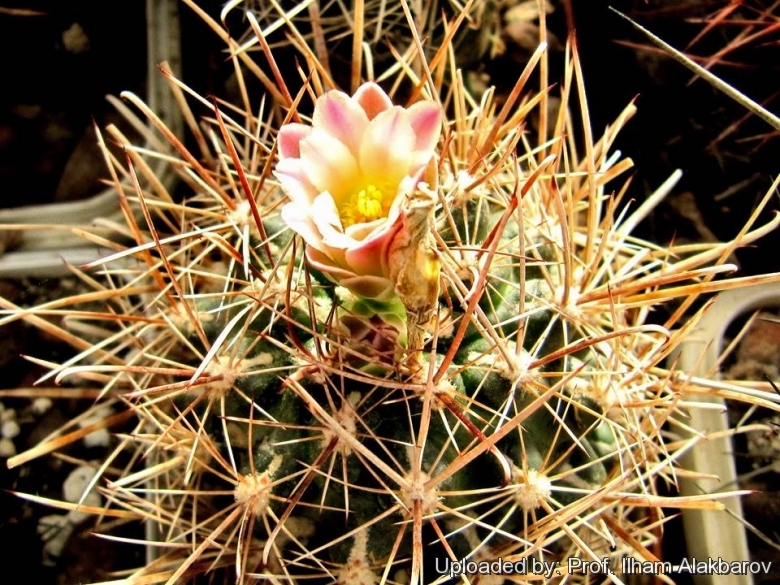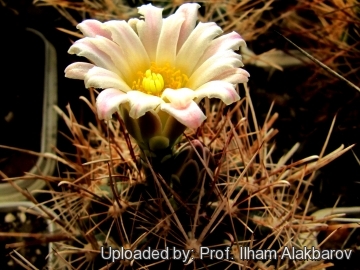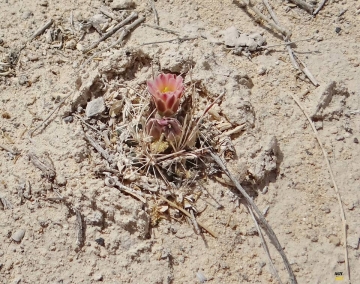




Your support is critical to our success.
Acta Succulenta 2(1): 35, figs. 1-16. 2014 [27 Mar 2014] [epublished]
Family: CACTACEAE

Origin and Habitat: North of, central part of Coahuila (Mexico, Northern America).
Altitude range: Around 700 metres above sea level.
Habitat and ecology: Ancistrocactus pinkavanusSN|31322]]SN|31322]] is found in an extreme ecological niche in the middle of one of the driest parts of the Sonoran desert. It grows in alluvial gypsophilous grassland, in clayish salty deposits (Bolson of Cuatrociénegas). During the long extreme drought, characteristic of this area (practically throughout the year) the stems of Ancistrocactus pinkavanusSN|31322]]SN|31322]] retract and drive under the dried mud into small cavities so the plants comes to be completely buried, covered by a thin layer of earth and dust which protect them from the sunlight and drough. This enable them to blend well with their surroundings rendering the plants extremely cryptic or even unnoticeable from the eyes of potential predators. It is only in wet periods that these plants become visible as they swell with the liquids absorbed by the roots. When the weather is rainy, the root is able to absorb the water quickly, so the plant appears rapidly on the surface. The stem enlarges, pushing some hooked spines and the photosynthetic crown above the level of the ground and bloom some weeks after the rain.
Synonyms:
- Ancistrocactus pinkavanus García-Mor., Gonz.-Bot. & Rodr.González
Description: Ancistrocactus pinkavanusSN|787]]SN|31322]] is a small member of the genus Ancistrocactus, which produce big and beautiful flowers. It is is a quasi-geophytic plants that disappear rapidly from sight below the soil surface, dormant even for months, covered by a layer of dust and dirt and also hiding it. Once the rains arrive and the water supply is sufficient to allow a good absorption, it can swell up and appear on the surface. This is largely possible because the stem of this plant, in particular its epigeous portion, can retract for several millimetres, especially in its lower portion, near the neck. This plants is able to survive dormant for several months, hidden below the surface, thanks to its enormous tuberous root, often bi or trifurcate, which often looks disproportionate to the stem.
Derivation of specific name: After Donald J. Pinkawa; North American botanist, specialist of the flora of the Cuatrociéngas region where the plant was found
Stems: Simple, unbranched, 1.5-8 cm tall, 1.5-7 cm wide, glaucous-green.
Roots: Carrot-like, fleshy, soft 5-10 cm long and 3-6 cm wide with secondary root distally, not separated from the stem by a constriction neck.
Tubercles: Arranged in ribs and spiralled in 8-11 series, conical, rounded 10-18 mm wide, 6-12 mm tall with a conspicuous woolly groove.
Areoles: Oval to near circular 3-5 mm in diameter, white-woolly.
Spines (juveniles spination): Young plants have only (6-)8-10(-11), 5-15 mm long radial spines per areole, white with reddish-brown tips. They are quite similar to other cacti, so they can be confused with other Cactaceae, such as juvenile forms of Mammillaria heyderiSN|20805]]SN|20805]] Muel., or Coryphanthas.
Spines (adult spination): Mature specimens develops 4 central spines pink and rigid, not flattened, the lower one occasionally hooked. White to brownish-red, spreading 20-35 mm long.
Flower: Its size is unusual for the genus Ancistrocactus, since it can exceed 4 cm in diameter and is able to emerge and open above the spines, thanks to a long pericarpel, adorned with few, big scales. The flowers emerges from the areolar groove. They are funnel-shaped to campanulate, 35-45 mm long, 25-40 mm wide pink, to magenta, The petals are large, silky, over 3 cm long and white with a purplish midstripe. A young plant, 2 cm in diameter, can develop a flower wider than 3 cm. Occasionally some specimens may bloom when they are still showing a juvenile spination, with no central spines.
Fruit: The fruit is large, sometimes 3 cm in length, green or reddish and contains large helmet-like seeds, 1.5-2 mm long, contained in a mucilaginous pulp. Scales greenish-white moon-shaped and papery.
Taxonomy: The characteristics of this plant are peculiar, even if we compare it with the form ‘megarhizus’ of Ancistrocactus scheeriSN|3503]]SN|787]] Britton& Rose, a plant typical of areas at low altitude, which also develops a big, tuberous root. The ecology of the Ancistrocactus pinkavanusSN|31322]]SN|31322]] is an important distinctive character from the rest of the species. The ‘megarhizus’ plant grows primarily in flat and gravelly areas, not on clayish alluvial plains, with strong accumulation of salts and having a quite distinct ecology from the plant from Cuatrociénegas. A clarification about the relationship between Ancistrocactus brevihamatusSN|787]]SN|3503]] and Ancistrocactus scheeriSN|31322]]SN|787]], presently considered as a distinct species. They are very similar in morphology and ecology except for a few characteristics, and some intermediate forms grow in the Mexican states of Coahuila and Nuevo León, with progressive intergradations, and consequently some in situ data could lead us to consider them as a single species.
Bibliography: Major references and further lectures
1) Donati D. “Ancistrocactus Britton and Rose, consideration on a quasi-geophytic plant.” in Acta Succulenta 1(1): 8-13 2013
2) García-Mor., Gonz.-Bot. & Rodr.González “Ancistrocactus pinkavanus (Cactaceae), A new species from Northern Mexico” Acta Succulenta 2(1): 35, figs. 1-16. 2014
3) Doweld, A.B. “Il genere Ancistrocactus Br. & R. Relazioni filogenetiche e classificazione”, in Cactus & Co 2(5), 60-102. 2001
4) Hunt D. & al. “The New Cactus Lexicon” 2006

Ancistrocactus pinkavanus Photo by: Prof. Ilham Alakbarov

- In habitat. Photo by: Agócs György
Cultivation and Propagation: This plant is relatively rare in cultivation and has the fame to be difficult to grow on its own roots because it is very sensitive to overwatering (rot prone) and slow-growing. This species is extremely xerophytic, cold hardy and adapted to very dry soils, but plants grafted on an hardy stock are easy to grow and no special skill is required.
Soil: Grow it in an open mineral, sandy-gritty cactus compost.
Pots: It needs a relatively large or deep pot to accommodate its extensive roots and provide a very good drainage. They may stay in the same pot for many years.
Watering: Water it sparingly and keep it completely dry during winter or when night temperatures remain below 10° C. Mature individuals easily rot and die especially after planting so be extremely cautious with watering. Water it less than average if in bigger pots.
Special need: Provide very good ventilation. Nearly all problems occur as a result of overwatering and poor ventilation, especially when weather conditions are dull and cool or very humid. They must have very dry atmosphere.
Fertilization: Feed them once during the growing season with a fertilizer specifically formulated for cactus and succulents (high potash fertilizer with a dilute low nitrogen), including all micro nutrients and trace elements diluted to ½ the strength recommended on the label. They thrive in poor soils and need a limited supplies of fertilizer to avoid the plants developing excess vegetation, which is easily attacked by fungal diseases.
Exposure: It will do its best with lots of sun and become stressed with inadequate light which could result in poor growth and unnatural shape.
Hardiness: An unheated greenhouse would be perfect. It can survive low temperatures, approx. -7° (-12°) C.
Use: This is a good pot plant suited for a non heated green house. It can be also cultivated outdoors in raised beds, terraces if sheltered from winter rain. This cactus continues to be, a particular prize among collectors.
Pests & diseases: These cacti may be attractive to a variety of insects, but plants in good condition should be nearly pest-free, particularly if they are grown in a mineral potting-mix, with good exposure and ventilation. Nonetheless, there are several pests to watch for:
- Red spiders: Red spiders may be effectively rubbed up by misting the plants from above.
- Mealy bugs: Mealy bugs occasionally develop aerial into the new leaves and flowers with disfiguring results, but the worst types develop underground on the roots and are invisible except by their effects.
- Scales, thrips and aphids: (they are rarely a problem.)
- Rot: Rot is only a minor problem if the plants are watered and “aired” correctly. If they are not, fungicides won't help all that much.
Propagation: Seeds are quite difficult to germinate and a low rate of success, seedling did not do well either, and some die each year. The seeds can be sown in pots of fine, well-drained sandy soil, any time during the spring when temperatures are warm. Cover the seeds with a fine layer of grit and water from below with a fungicide to prevent damping off. For the 1-2 weeks cover the pots with a sheet of glass/clear perspex to keep the humidity levels high. Remove the glass and replace it with light shade-cloth and mist once or twice a day for the next two weeks after which most seeds should have germinated. From then on mistings can be reduced to every second and then every third day as the little plants grow. Grafting is often used to speed growth rate and to create a back-up for plants in collection.
| Your Actions | |
|---|---|
| Back to Ancistrocactus index | |
| Back to Cactaceae index | |
 |
Back to Cacti Encyclopedia index |
Privacy stantement - Terms and conditions - How to cite - About us - Feedback - Donate




